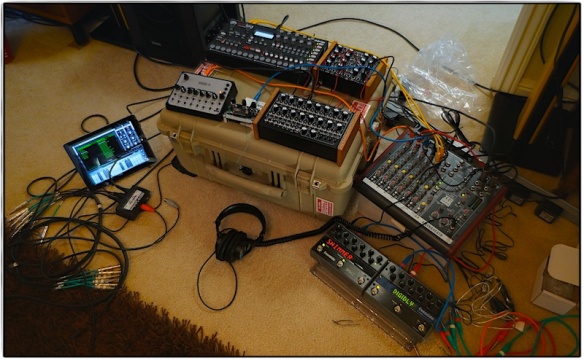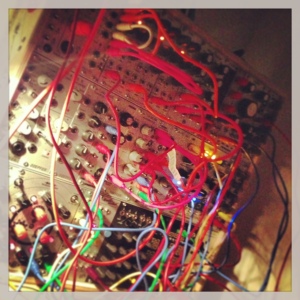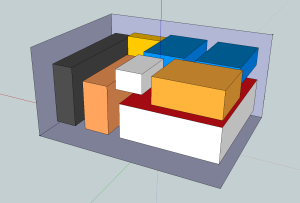I’m about to head out on the road for a couple of months or so which means I wont have access to my regular music making machines. All the keyboards, synths and the modular and other gear will be out of reach.
Naturally I can’t go for 2 months without making music, and so I was researching various ways of staying productive while on the road. I came up with 4 different alternative setups that I think would have worked for me. I’m sure there are others but those are the ones that felt viable in terms of what I was looking for.
Figuring there might be others looking for the same I decided to write up a short explanation of how and what I ended up with.
Scroll down to the end for pictures of the end result :).
First the Criteria:
- Portable
I wanted a system that I could carry or lug around without too much effort. Pocket size was not a requirement. - No Computer / DAW dependency.
I wanted to be able to set it up and jam / mess around without having a computer nearby. - New
I wanted the setup to be a new learning experience with gear and/or a workflow that I had not used before. Also, I wanted those learnings to be relevant not just to the system at hand but for other scenarios / tech / workflows as well. - Full circle
The system had to be capable of producing a full track with all parts and sounds necessary (under realistic constraints of course).
Option 1. The Groovebox
At first I was looking at various self-contained groove boxes like the Korg Electribes and the Roland MCs. They are certainly capable boxes, but the Rolands I ruled out right away as being to big for their feature sets, and having to out-dated i/o options. The MC808/909 looks like a lot of fun, and as a future addition to the studio I think they would be great, but not for on-the-road work. On the other hand the Electribes have the perfect size but felt like they were to restricted sonically (at least for the type of music I want to create). Finally, any workflow or techniques that I would learn from these boxes felt like they would be tied very closely with the particular box and not translate well to other tools.
Option 2. The Pocket Synth
Unless you’ve been living under a rock the last year or two you know about the Teenage Engineering OP-1 synth. A fantastic little instrument that is kind of like a groove box on steroids, shrunk to fit in your palm. However, the hardware has gotten a lot of negative reviews/feedback as a novelty toy, and with little to no expansion options, for the price it felt like a very limited way to go. Also, the OP-1 seemed like a dead end in terms of live, cooperative jamming. I’m all for setting up constraints to explore creativity but the OP-1 was simply to far from where I’m heading with my music.
Option 3. All Software
While certainly the most portable solution, this violates the 2nd criteria. And seriously, how fun is that?? ;-)
Option 4. The Portable Studio
So finally I started asking my self what the minimum required instruments are to be able to create the music I strive for without a DAW or any of my larger modular systems or synths. What would it take to essentially shrink down the sonic palette that I want to work with into a system that would meet the 4 criteria and also be fun and inspiring to work with.
I knew I would want some kind of percussion / drum sequencer, a dedicated bass voice, at least 1 dedicated lead voice, something to experiment with for atmospheric sounds and effects, and some way of mixing all the voices together.
Looking at what I had at hand I decided that my Elektron Analog Four should have a spot in the setup, as well as the Meeblip. For effects I could bring my Eventide Space and Timefactor pedals, and to spice things up even more I ordered a Nebulophone from Bleep Labs. Next I needed some form of note / melody source so I decided to include a Doepfer Dark Time sequencer, and for percussion a Korg Volca Beats. Also, to add another voice to the mix, and because it pairs so well with the Dark Time, I’m considering throwing in a Dark Energy synth as well. Finally to mix them all together I’ve included an Allen & Heath ZED10-FX mixer which will also allow me to record the stereo mixdown over USB to a computer.
I figured I could build a custom, heavy duty but portable, case that would hold all of this gear so I started looking into custom ATA cases, but a friend pointed me in the direction of the Pelican brand cases instead. Those cases come in a huge variety of sizes and colors so after some measuring and careful modeling in SketchUp I decided to go for one of those.
In the end I would agree that this setup is far from the most simple or portable solution, but it feels extremely inspiring and I can’t wait to set this rig up and start exploring it.
If you have any questions about the case or any of the gear inside it please leave a comment and I will answer as best I can.
Here’s a complete list of the gear:
- 1x Allen & Heath ZED10-FX Mixer
- 1x MeeBlip SE
- 1x Korg Volca Beats (to be added in Japan)
- 1x Elektron Analog Four
- 1x Eventide Space
- 1x Eventide TimeFactor
- 1x Doepfer Dark Time
- 1x Bleep Labs Nebulophone
- 1x Doepfer Dark Energy mkII (TBD)
- 1x Pelican Cases 1610

Jamming with the setup.





Pingback: SKB 61 Key Case For Access Virus TI2 | Glitzerstrahl
Pingback: Pelican cases are amazing! | Glitzerstrahl
That is an ingenious setup that I’d imagine is very versatile. As you know I went for a OP1 which I love and find ticks many boxes for me but as I can see within your setup perhaps is not suitable. It looks like the way that all your kit can essentially affect each other, be tricky for the little OP to offer much there. I’d be interested to hear how yo hard getting on with this setup, also how long on average does it take to setup?
LikeLike
Nice set up!
However, your idea of portable and my idea of portable are quite different! :) For me, portable means battery powered only.
:)
LikeLike
gazgoldstar > It’s actually been really fun to travel and play with this setup. The time to set it up depends a little on what parts I include and how I setup the midi routing, but on average I would say it takes about 10 minutes with all the cables.
I have travelled with it within the US, to Japan and to Sweden so far and the case has been absolutely awesome. I feel totally secure checking all this gear in when flying..
LikeLike
Daniel Davis > Yup I see your point. I think the purpose and workflow is probably a little bit different but they both have their strengths. I certainly would not mind getting an OP-1 as well to be able to do exactly what your picture shows…. that will be a future investment though :).
LikeLike
Ah yes – two very different methods going on, serving different purposes I think.
LikeLike
Pingback: I’m not making music… | Glitzerstrahl